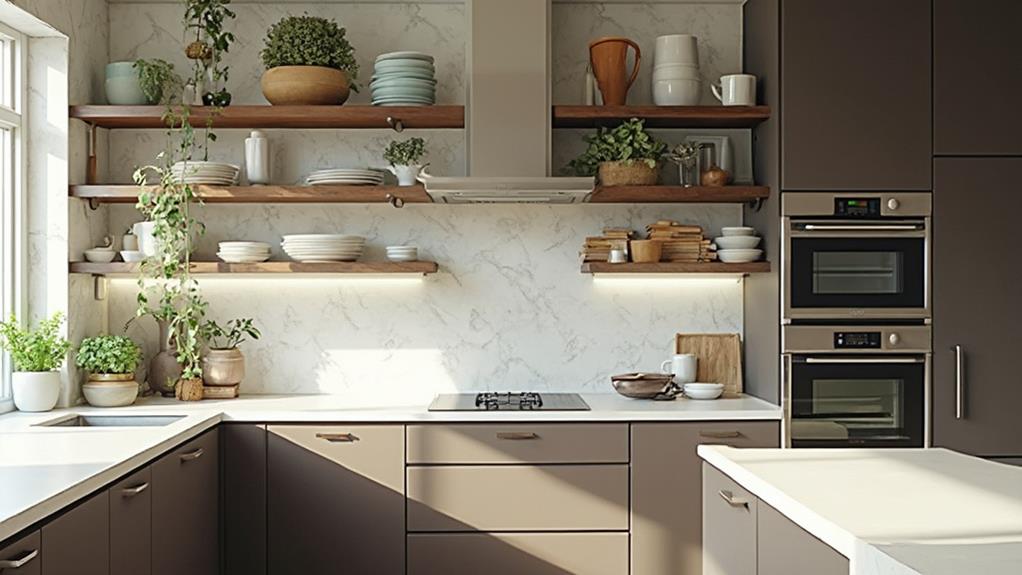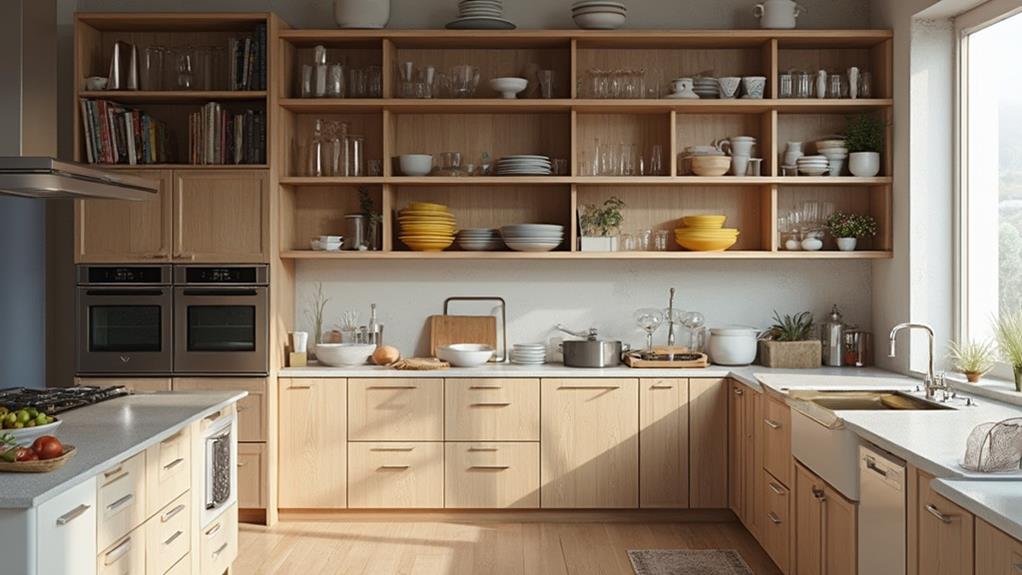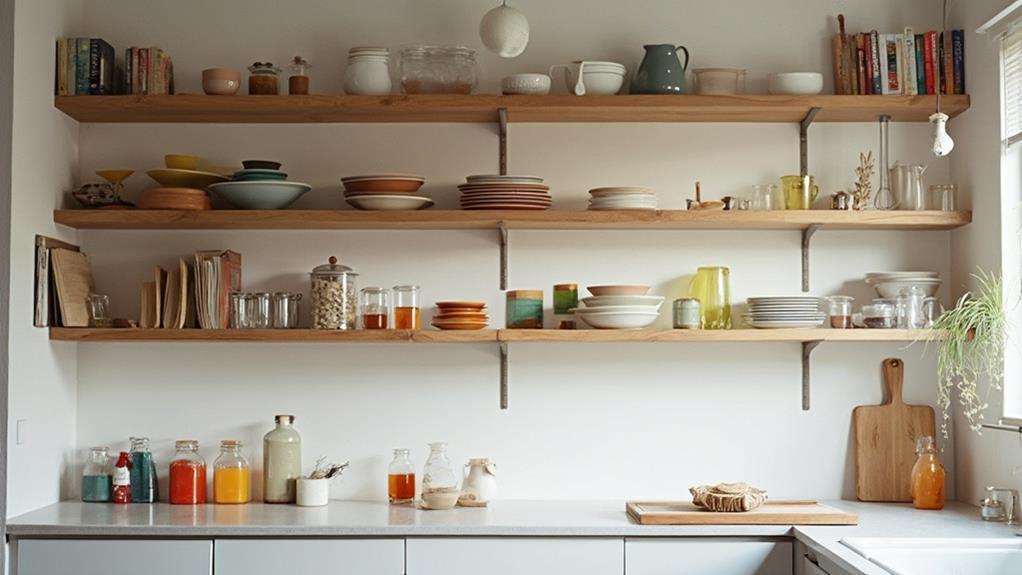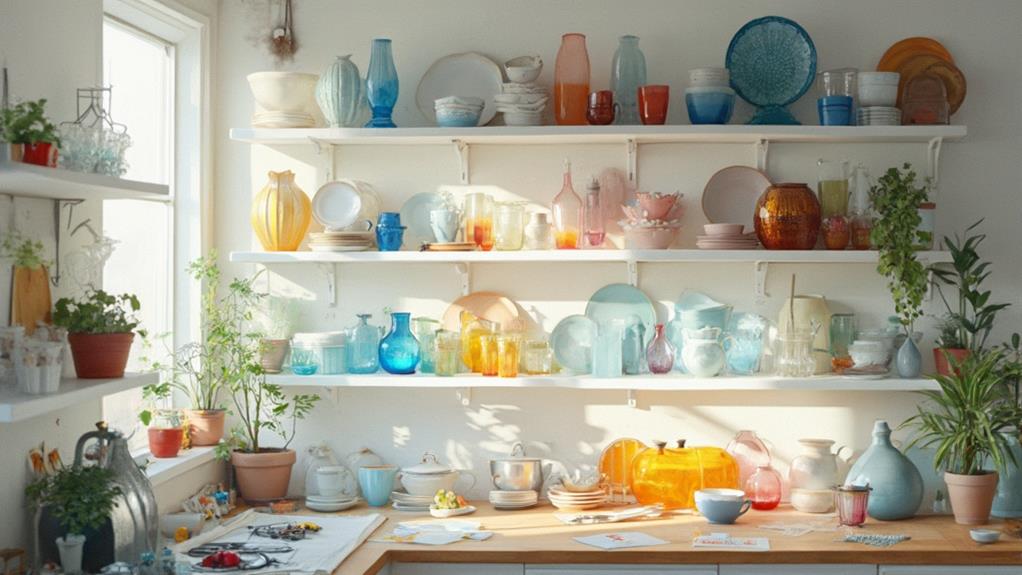Open shelving in kitchens can transform your space, creating an airy feel and showcasing your favorite dishes. You'll enjoy easy access to items and a more streamlined cooking process. It's often cheaper than traditional cabinets, making it budget-friendly. However, you'll need to keep things tidy and dust-free, as clutter becomes instantly visible. While open shelves offer flexibility in design, they provide less storage than closed cabinets. You might find yourself reorganizing more frequently and investing in attractive dishware for display. Weighing these factors carefully will help you decide if open shelving aligns with your kitchen needs and lifestyle. Let's explore each aspect in detail.
Aesthetic Appeal

Open shelving can truly spruce up your kitchen's look. It creates an airy, spacious feel that can make even small kitchens appear larger. You'll have the opportunity to showcase your favorite dishes, glassware, and decorative items, turning them into functional art pieces. This display can add character and personality to your kitchen, reflecting your unique style and taste.
Color coordination becomes easier with open shelves, allowing you to create visually appealing arrangements that complement your kitchen's overall design. You can mix and match different textures and materials, such as wood, metal, or glass, to add depth and interest to your space.
However, the aesthetic appeal of open shelving comes with challenges. You'll need to maintain a tidy appearance constantly, as clutter will be visible to everyone. Dust accumulation on exposed items can be an issue, requiring more frequent cleaning. Additionally, not all kitchenware is visually appealing, so you may need to invest in attractive storage containers or relocate less attractive items.
Ultimately, the aesthetic success of open shelving depends on your ability to curate and maintain an organized, visually pleasing display.
Space and Accessibility
Beyond aesthetics, the functionality of open shelving in kitchens is a key consideration. When it comes to space and accessibility, open shelving offers both advantages and drawbacks.
You'll find that open shelves can make your kitchen feel more spacious. Without bulky cabinet doors, the room appears larger and more open. This illusion of extra space can be particularly beneficial in smaller kitchens. Additionally, open shelving provides easy access to your items. You won't need to open cabinet doors or search through cluttered spaces to find what you need. Everything is visible and within reach, streamlining your cooking process.
However, the lack of doors means you'll have less storage space overall. You can't stack items as high or deep as you'd in closed cabinets. This limitation might force you to be more selective about what you keep in your kitchen. Open shelving also requires more frequent cleaning and organization. Dust and grease can accumulate on exposed items, and a cluttered shelf can quickly make your kitchen look messy. You'll need to be diligent about maintaining order and cleanliness to keep your open shelves functional and attractive.
Cost Considerations

When weighing the decision to install open shelving, you'll need to factor in the financial aspects. Open shelving can be a cost-effective option compared to traditional cabinets, especially if you're on a tight budget. The materials for open shelves are generally less expensive, and you'll save on cabinet doors and hardware. Installation costs can also be lower, as it's often a simpler process that you might even tackle as a DIY project.
However, don't overlook potential hidden costs. You may need to invest in more attractive dishware and storage containers since everything will be on display. Additionally, you might find yourself replacing items more frequently due to increased exposure to dust and potential damage. If you're replacing existing cabinets, factor in removal and disposal costs.
Consider long-term value as well. While open shelving is trendy now, it may not appeal to future homebuyers if you're planning to sell. This could impact your home's resale value. Ultimately, weigh these cost considerations against your aesthetic preferences and practical needs to make the best decision for your kitchen and budget.
Maintenance and Cleanliness
Dust bunnies and grease splatters become more visible foes when you opt for open shelving in your kitchen. You'll need to clean your dishes, glasses, and decorative items more frequently as they're exposed to airborne particles and cooking residue. This increased maintenance can be time-consuming, especially if you have a busy lifestyle.
On the flip side, the visibility of your kitchenware can motivate you to keep things tidy. You're more likely to stay organized when everything's on display. This can lead to better overall cleanliness in your kitchen.
However, you'll need to be mindful of what you store on open shelves. Items that aren't used often may collect dust, requiring extra attention before use. Cooking oils and spices can also degrade faster when exposed to light and air, so you'll need to rotate them more frequently.
Consider the layout of your kitchen when deciding on open shelving. If it's near your cooking area, you might find yourself wiping down surfaces more often to combat grease buildup. Ultimately, the maintenance required for open shelving depends on your cooking habits and willingness to keep things clean and organized.
Functionality and Storage

From a functionality standpoint, open shelving offers both advantages and challenges. You'll find that it provides easy access to frequently used items, allowing you to grab dishes, glasses, or ingredients quickly. This can streamline your cooking process and make your kitchen more efficient. Open shelves also encourage you to be more organized, as everything is visible and within reach.
However, you'll need to consider the storage limitations of open shelving. Unlike closed cabinets, they don't offer as much space for bulky appliances or rarely used items. You might find yourself struggling to store large pots, pans, or specialty kitchen gadgets. Additionally, you'll need to be mindful of how you arrange items on open shelves to maintain a tidy appearance.
On the plus side, open shelving can maximize vertical space in smaller kitchens, giving you more storage options than traditional cabinets. You can also adjust shelf heights to accommodate taller items or create custom storage solutions. Ultimately, the functionality of open shelving depends on your specific needs and how you use your kitchen space.
Conclusion
You've weighed the options, considered the pros and cons. Open shelving promises beauty and accessibility, but at what cost? Will you embrace the challenge of keeping everything pristine, or opt for the safety of closed cabinets? The choice isn't easy, but it's yours to make. As you stand in your kitchen, picturing the possibilities, remember: your decision will shape not just your space, but your daily life. What will you choose?

